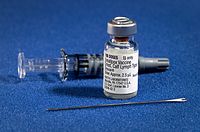
Photo from wikipedia
Vaccines are one of the effective measures of public health practice and preventative medicine to protect the population from diseases and infections. They have contributed to decreasing rates of common… Click to show full abstract
Vaccines are one of the effective measures of public health practice and preventative medicine to protect the population from diseases and infections. They have contributed to decreasing rates of common childhood diseases and infant and childhood mortality. In some cases, vaccination wiped out diseases that were common in years past, such as smallpox, and have nearly eradicated polio [1]. Resistance to and rejection of vaccination is not a novel phenomenon. There have been anti-vaccination movements at least since 1796 when Edward Jenner invented the smallpox vaccine; however, then, most of the claims against vaccines were witchcraft/ religion related. Later, in the nineteenth century, debates around vaccination shifted toward a more scientific approach, but lack of understanding of immune mechanisms still left the vaccination phenomenon unexplained and suspicious. The modern version of the phenomenon can be traced to two significant events: first is the infamous Cutter incident in 1955, in which due to a failure during the production, some batches of polio vaccine given to the public contained live polio virus and as a result significantly undermined the public trust in vaccination, even though it has a factual basis of a real polio outbreak; however, in 1982 anti-vaccination trends turned into the pseudo-scientific direction when NBC broadcasted a documentary, “DPT: Vaccine Roulette”, which discussed controversy spreading in the UK: a suspected connection between the vaccine for pertussis and seizures in young children [2]. Despite the confusion from the public response and appar-
Journal Title: Wiener Klinische Wochenschrift
Year Published: 2021
Link to full text (if available)
Share on Social Media: Sign Up to like & get
recommendations!